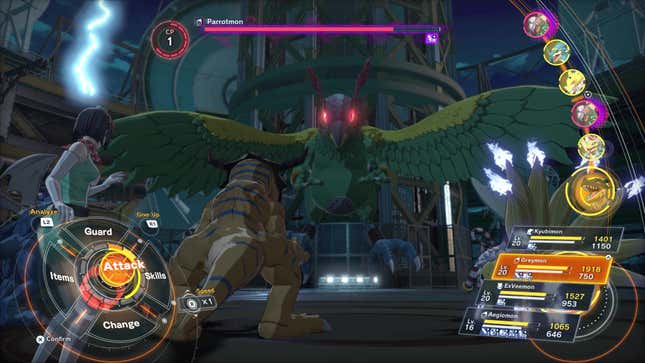Time Stranger Shows The Series Is Still Growing
Remember how, when Palworld was blowing up, fans were excited that a Pokémon competitor might force The Pokémon Company to get its act together and stop releasing busted games like Scarlet and Violet? Whether that pans out remains to be seen, but given that Digimon, arguably the most notable competition Pokémon had in the 90s and early 2000s, has been quietly running circles around Pikachu and friends on the video game side for years, I’m not holding my breath. I played about half an hour of Digimon Story: Time Stranger at Summer Game Fest earlier this month, and though my time with the RPG was brief, it was a succinct reminder that Digimon has been cooking up some excellent, polished RPGs in its own lane. The last mainline Story game, Cyber Sleuth, was a hidden gem of 2016, so I’m hopeful Time Stranger breaks through the noise when it launches later this year.
If you’ve ever played Digimon or watched the anime, you know the general conceit of the franchise. The titular critters live in a digital world that humans are able to enter via virtual reality. Time Stranger focuses on a different “server” than the one where previous Story games took place and is set in the digital world of Iliad, managed by a powerful pantheon of Digimon called the Olympos XII.
As a longtime Digimon fan, I’ve always been drawn to how the games riff on the lore by finding new ways to implement old characters and mythological figures into new iterations of the Digital World, and Time Stranger already has me intrigued. Recent Story games were set in a somewhat barren cyberspace world that was aesthetically compelling in a minimalist way, but weren’t that stimulating to walk around in. Time Stranger’s shift to Iliad not only opens up the visual identity of these games to include lush environments and lively towns filled with Digimon living in harmony; it’s also paving the way for new stories with different major players. Cyber Sleuth was a sort of Avengers moment for some of the series’ mainstays, so Time Stranger putting the focus on the Olympos XII for the first time in several years is an exciting prospect.

In the short time I was able to spend in Iliad’s Central Town hub, I was excited to explore and meet all the Digimon living there as civilians, unbothered by the petty squabbles of humanity in the real world. There’s so much character to this little town that even as the game pans over it in a cutscene, so many lively details catch your eye. Little touches like seeing Zudomon using its hammer to pound away on an anvil as a blacksmith and Etemon hanging off the signage on the buildings make the town feel lived in, and nearly every inch of the town is covered in Digimon interacting with the world and each other like this.
I didn’t plan to spend most of my time playing Time Stranger comparing it to Pokemon, but the stark difference between it and Game Freak’s RPGs is top of mind for me right now after playing a bit of Scarlet and Violet on Switch 2. Yeah, the games finally run at a smooth 60 frames-per-second, but the world still looks and feels like a GameCube-era tech demo, whereas Time Stranger, and Digimon games more broadly, feel like childhood dreams realized. They take risks, change up the formula constantly, and most importantly, they feel like fully realized worlds visually, narratively, and systemically. Whether it’s been in the Story series, the World games, or more off-the-wall spin-offs like the the visual novel tactics RPG Digimon Survive, this franchise has never stopped swinging for the fences, even after it was deemed the “loser” of the ‘90s and ‘00s monster tamer race. Maybe that’s what happens when you still feel like you’ve got something to prove and can’t rest on your guaranteed millions of sales. There’s some freedom in not being beholden to the same machine your rival is, and it makes for more interesting games.

While exploration is much more of a priority this time around, Time Stranger is still focused on the monster taming aspect above all else. With more than 450 Digimon available to you, there’s a lot of room for experimentation in what might look, at a glance, like a pretty straightforward turn-based battle system. Time Stranger still utilizes the rock-paper-scissors structure Digimon always has, but it also has a Final Fantasy X-style swapping system that lets you adjust your strategies on the fly by switching between your active party and your benched teammates without penalty. Some of the battles I took part in were your standard random fight affair, but the boss fight against a super-powered Parrotmon really showed the potential of its turn-based battles. This clash felt more like a raid battle that required a lot more setup with support abilities, pushing me to prioritize defense rather than just bulldozing through with my most powerful attacks, and demonstrating that Time Stranger could be more dynamic than its predecessors.
Cyber Sleuth’s story and Persona-esque vibe were the draw above all else, with some critics arguing that the battle system was generic and uninvolving. (Kotaku’s Mike Fahey called them“a mindless chore.”) Time Stranger, by contrast, is certainly not reaching the elaborate, systems-heavy turn-based play of something like Clair Obscur: Expedition 33, but what I played of it suggests developer Media.Vision is taking that criticism to heart, and I”m interested to see just how far it can take these systems when the game launches on PC, PS5, and Xbox Series X/S on October 3.














Post Comment